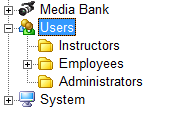 Test administrators are referred to as "t.admins“. Instructors, trainers and teachers are grouped together as "instructor-level users" or "t.authors". Anyone taking tests: employees, pre-hires, trainees, students or customers are "t.takers". Question banks are "qbanks" and questions, "items".
Test administrators are referred to as "t.admins“. Instructors, trainers and teachers are grouped together as "instructor-level users" or "t.authors". Anyone taking tests: employees, pre-hires, trainees, students or customers are "t.takers". Question banks are "qbanks" and questions, "items".
![]() Best Practices
Best Practices
 About Rescore Test
About Rescore Test
Rescore Test enables a t.author to "disallow" a bad test item. In a typical scenario the t.author publishes a test which is taken and contains test scores. After analyzing the test results, the t.author realizes that the test contains a "bad" item, we'll call it bi-1.
The t.author mistakenly marked "A" as the correct answer instead of "D". They want to continue giving the test, so they log in to TG, open the test, locate bi-1, change its point value to "0", save the change and then select Tools > Rescore Test.
Scores recorded prior to re-scoring, would be re-calculated, removing bi-1 from the total test score calculation: bi-1 would remain in the test but no t.taker would receive credit for it. This would also apply to any future test attempts.
 Best Practice: Assuming bi-1 had been imported from a q.bank, we recommend locating the item in the q.bank and making a journal entry under bi-1's Notes field. The t.author could also "flag" the item by adding "Do not use." in front of the question stem. Important, bi-1 should NOT be resynced.
Best Practice: Assuming bi-1 had been imported from a q.bank, we recommend locating the item in the q.bank and making a journal entry under bi-1's Notes field. The t.author could also "flag" the item by adding "Do not use." in front of the question stem. Important, bi-1 should NOT be resynced.
The t.author could also make a copy of bi-1 by highlighting it in the q.bank's summary table, and then selecting the icon toolbar's Copy and Paste buttons, or select the text menu Test Settings > Clone Question.
Note: the copy of bi-1 would receive a unique Q_ID. This Q_ID would be different than bi-1's Q_ID and could not be resynced into any test that contained the original bi-1. However, the new, corrected item could be imported into a any new test, that did not contain any scores.
/1
IF the t.author didn't want to keep any of the test scores, they could delete them from the test's Scores tab, then edit and correct b1-1, in the test and the question bank. This is an acceptable practice when a t.author is in the process of creating a new test, enrolling peer evaluators and having them take the test. Best practice: we recommend doing this in a Sandbox course that is only accessible to the t.author's (enrolled) peer evaluators.
/2
IF the t.author has created a practice test, and has no intention of keeping the test scores, they could freely edit the test, making whatever changes they wanted without having a negative impact on reporting and analysis. If bad items were discovered, and the t.author wanted to achieve a good practice test, we would recommend deleting the bad item from the test, correcting it in the question bank, and then re-importing it into the test.
/3
IF the t.author creates a test by manually typing in questions or importing then from a TG-friendly file, and....
Changes: Allowed
Changes: NOT Allowed
Test Generator does not prevent the t.author from making these changes; however, once made there is no Undo option.
Applying any of the "NOT Allowed" settings to q.bank items--and then re-syncing them--will lead to corrupted test data. This applies to any test that...
The t.author would end up with two sets of data that do not match.

Set_1 consisting of test data before the resync change, and
Set_2 consisting of test data after the resync change
Does this matter? Yes, it matters if your organization is...